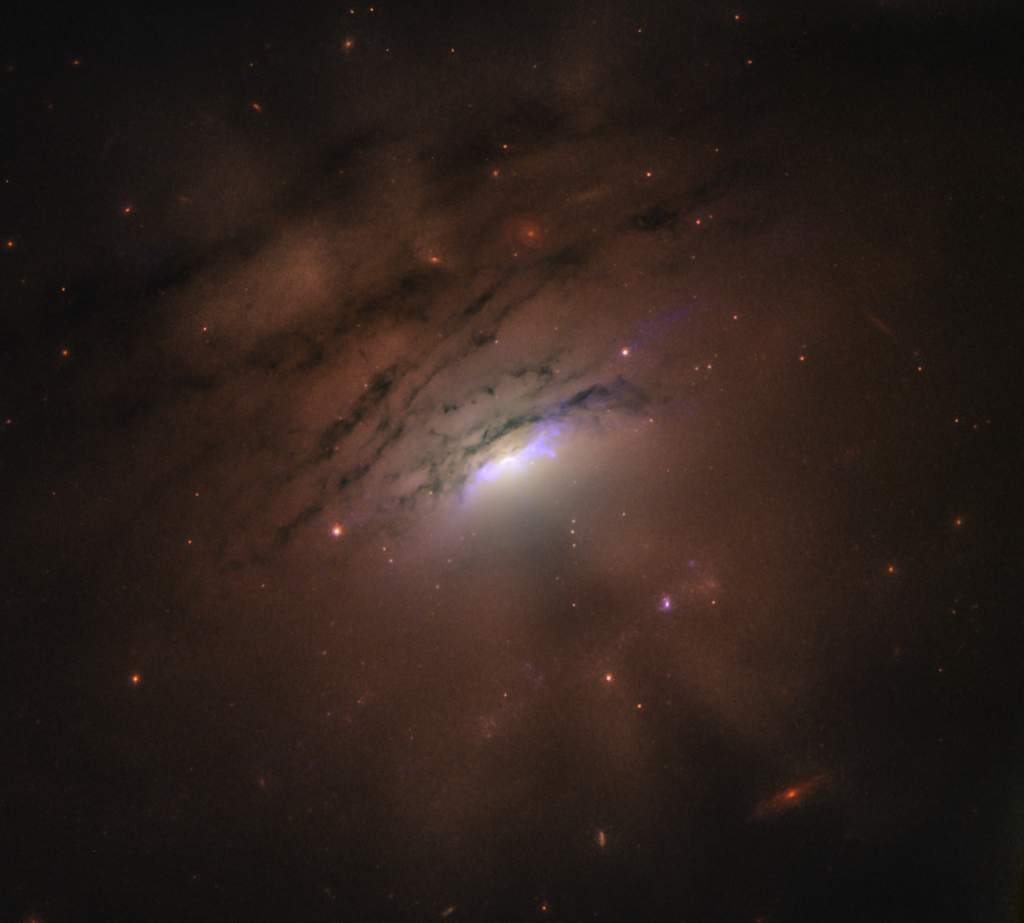Some of the most stunning views of our sky occur at sunset, when sunlight pierces the clouds, creating a mixture of bright and dark rays formed by the clouds’ shadows and the beams of light scattered by the atmosphere. Astronomers studying nearby galaxy IC 5063 are tantalized by a similar effect in images taken by NASA’s Hubble Space Telescope. In this case, a collection of narrow bright rays and dark shadows is seen beaming out of the blazingly bright center of the active galaxy.
A team of astronomers, led by Peter Maksym of the Center for Astrophysics | Harvard & Smithsonian (CfA), in Cambridge, Massachusetts, has traced the rays back to the galaxy’s core, the location of an active supermassive black hole. A black hole is a dense, compact region of space that swallows light and matter under the crushing pull of gravity. The monster object is frenetically feeding on infalling material, producing a powerful gusher of light from superheated gas near it.

Credits: NASA, ESA, and W.P. Maksym (CfA).
Although the researchers have developed several plausible theories for the lightshow, the most intriguing idea suggests that an inner-tube-shaped ring, or torus, of dusty material surrounding the black hole is casting its shadow into space.
According to Maksym’s proposed scenario, the dust disk around the black hole doesn’t block all of the light. Gaps in the disk allow light to beam out, creating brilliant cone-shaped rays similar to the fingers of light sometimes seen at sunset. However, the rays in IC 5063 are happening on a vastly larger scale, shooting across at least 36,000 light-years.
Some of the light hits dense patches in the ring, casting the ring’s shadow into space. These shadows appear as dark finger shapes interspersed with bright rays. These beams and shadows are visible because the black hole and its ring are tipped sideways relative to the plane of the galaxy. This alignment allows the light beams to extend far outside the galaxy. This interplay of light and shadow offers a unique insight into the distribution of material encircling the black hole. In some areas, the material may resemble scattered clouds. If this interpretation is correct, the observations may provide an indirect probe of the disk’s mottled structure.
“I’m most excited by the shadow of the torus idea because it’s a really cool effect that I don’t think we’ve seen before in images, although it has been hypothesized,” Maksym said. “Scientifically, it’s showing us something that is hard—usually impossible—to see directly. We know this phenomenon should happen, but in this case, we can see the effects throughout the galaxy. Knowing more about the geometry of the torus will have implications for anybody trying to understand the behavior of supermassive black holes and their environments. As a galaxy evolves, it is shaped by its central black hole.”
Studying the torus is important because it funnels material toward the black hole. If the “shadow” interpretation is accurate, the dark rays provide indirect evidence that the disk in IC 5063 could be very thin, which explains why light is leaking out all around the structure.
Observations of similar black holes by NASA’s Chandra X-ray Observatory detected X-rays leaking out of holes in the torus, making the structure appear like Swiss cheese. The holes may be caused by the disk being torqued by internal forces, causing it to warp, Maksym said. “It’s possible that the warping creates big enough gaps for some of the light to shine through, and as the torus rotates, beams of light could sweep across the galaxy like lighthouse beams through fog,” he added.
The team’s results were published in The Astrophysical Journal Letters with the title “Crepuscular Rays from the Highly Inclined Active Galactic Nucleus in IC 5063”. Source:nasa.gov
